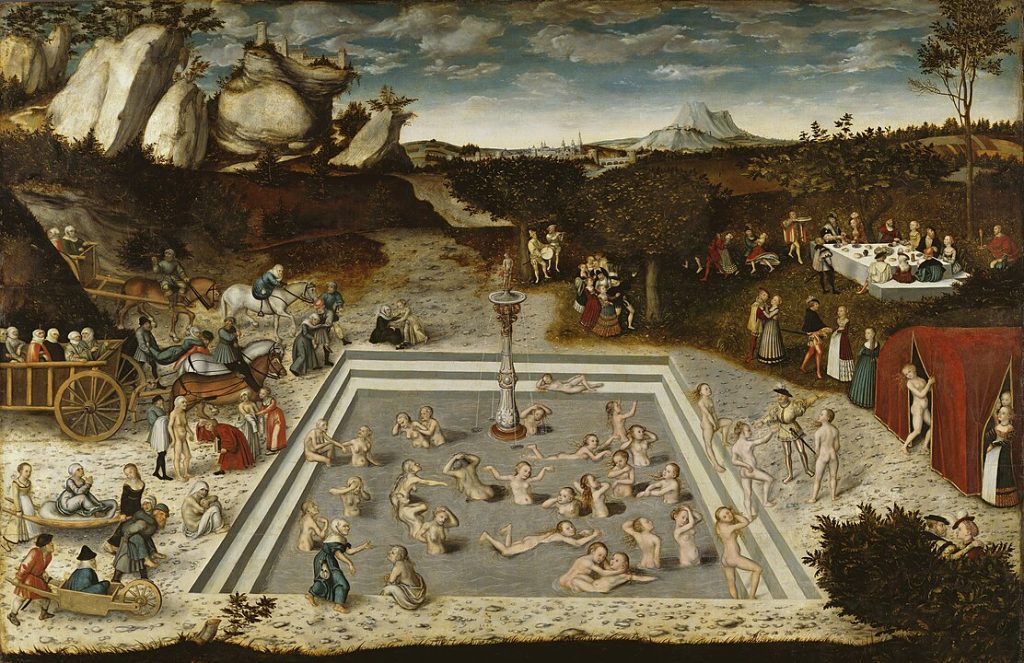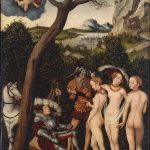
Lucas Cranach the Elder was one of the most significant painters of the Northern Renaissance, known for his distinctive style, which blended Gothic tradition with the emerging ideals of the Renaissance. His works often feature elongated figures, detailed textures, and a refined, almost decorative use of line and color. A court painter for the Electors of Saxony, Cranach was deeply involved in the Protestant Reformation and created both religious and mythological works that remain celebrated today. Below are ten of his most outstanding paintings, each with a detailed two-paragraph description.
1. The Judgment of Paris (circa 1528-1530)
This masterpiece exemplifies Cranach’s elegant yet sensual style, depicting the fabled beauty contest between the goddesses Hera, Athena, and Aphrodite, judged by the Trojan prince Paris. The three goddesses stand in contrapposto, nearly identical in their elongated, graceful forms, a hallmark of Cranach’s style. Unlike classical interpretations of the myth, Cranach places the scene in a dense forest, blending Northern European landscape traditions with mythological subject matter. Paris, dressed as a contemporary Saxon huntsman, sits in the background, making his fateful choice while Hermes watches with a knowing gaze. The painting’s delicate detail, from the sheer fabrics to the soft, porcelain-like skin of the goddesses, demonstrates Cranach’s ability to merge Germanic precision with Italian Renaissance ideals.
The work reflects the taste of Cranach’s patrons, who favored refined eroticism and allegorical themes. Rather than emphasizing dramatic action, Cranach’s painting presents a calm, almost decorative arrangement, as if the figures were pieces in a courtly tableau. The intricate detailing of their jewelry and headpieces adds an ornamental quality, reinforcing the artist’s affinity for fine craftsmanship. The painting also carries a moral subtext, as it subtly warns of the consequences of lust and desire—an underlying theme in much of Cranach’s mythological works.
2. Adam and Eve (1526)
Cranach’s Adam and Eve presents a highly stylized interpretation of the biblical couple in paradise. Unlike the muscular, anatomically idealized figures found in Italian Renaissance depictions, Cranach’s Adam and Eve are slender, elongated, and marked by an almost doll-like refinement. The scene is set within a lush, dark forest, reinforcing the Northern European preference for detailed naturalistic settings. Eve reaches out to take the apple from the serpent, while Adam watches her with an expression that blends curiosity and hesitation. The composition’s calmness belies the gravity of the moment, reflecting Cranach’s preference for elegant restraint over overt dramatization.
The presence of forest animals—including a stag, a hare, and a pair of birds—adds a sense of harmony and natural beauty before the Fall. These animals also carry symbolic meanings; the stag, for instance, often represents Christ, while the hare is sometimes associated with lust. Cranach’s Adam and Eve is notable for its combination of religious solemnity and sensual appeal, a balance that would make his work highly influential in Reformation-era Germany. His interpretation of the human form, with its elongated limbs and porcelain-like skin, became a signature of his artistic legacy.
3. Venus and Cupid (1531)
One of Cranach’s most celebrated mythological works, Venus and Cupid epitomizes his courtly eroticism. Venus, depicted as a slender, long-limbed beauty with an enigmatic expression, stands nude against a dark green forest. Beside her, Cupid mischievously holds a honeycomb while bees sting him, a metaphor for the pains that accompany love. Venus wears only a transparent veil and an elaborate Renaissance-style hat, adding an element of contemporary fashion that bridges the gap between antiquity and Cranach’s own time.
This painting is a prime example of Cranach’s ability to imbue mythological subjects with a delicate sensuality that remained acceptable within the courtly culture of the Saxon Electorate. The Venus figure, rather than exuding classical grandeur, appears delicate, almost ethereal, with impossibly smooth, pale skin. Her expression is serene yet knowing, embodying both beauty and the power of seduction. The inclusion of Cupid suffering from the bee stings subtly reinforces the idea that love, though sweet, is accompanied by pain—a moral lesson cleverly woven into the work’s visual elegance.
4. The Three Graces (1531)
In The Three Graces, Cranach presents a striking and unconventional interpretation of the classical trio. The three women, depicted as nearly identical, stand closely together, their elongated bodies forming a graceful rhythm. Unlike the voluptuous forms typical of Italian Renaissance depictions of the Graces, Cranach’s figures are slender, almost weightless, with small breasts and delicate limbs. Their poses are subtly choreographed, creating a sense of quiet intimacy rather than movement.
Cranach’s approach to nudity is both erotic and restrained, characteristic of his work at the Saxon court. The translucent veils and pearl jewelry add an air of sophistication, reinforcing the connection between classical beauty and Renaissance fashion. Unlike Botticelli’s or Raphael’s idealized interpretations, Cranach’s version emphasizes a distinctly Northern European aesthetic—sharp contours, pale complexions, and an elegant linearity. This painting stands as one of his most refined and poetic visions of the female form.
5. Lucretia (1528)
A subject Cranach returned to multiple times, Lucretia portrays the tragic Roman noblewoman moments before her suicide. She stands in a nearly frontal pose, nude except for an elaborately detailed veil and headdress. Her body, elongated and delicate, conforms to Cranach’s signature aesthetic, while her face bears an expression of quiet sorrow. In her right hand, she holds the dagger that will end her life, symbolizing both virtue and tragedy.
Cranach’s Lucretia is notable for its restrained drama. Unlike more theatrical depictions of her suicide, he presents her in an almost meditative state, heightening the painting’s psychological impact. The contrast between her soft, unblemished skin and the fatal weapon reinforces the theme of purity violated by violence. This balance of beauty and tragedy made the painting deeply resonant in an era fascinated by virtue and honor.
6. Martin Luther (1529)
Cranach was closely associated with Martin Luther and played a major role in shaping the visual identity of the Reformation. His Martin Luther portrait captures the reformer with remarkable realism and psychological depth. Dressed in his characteristic black robe, Luther appears serious yet calm, his steady gaze conveying intellectual conviction.
This portrait was widely reproduced, becoming an iconic image of Luther across Protestant Europe. Cranach’s skill in portraiture lies in his ability to emphasize individual character while maintaining a clear and accessible style. His partnership with Luther extended beyond art, as Cranach also designed early Protestant woodcuts and book illustrations.
7. The Fountain of Youth (1546)
In this fantastical painting, Cranach presents a mythical Fountain of Youth, where elderly people enter a pool and emerge rejuvenated. The composition is filled with figures in various states of undress, reinforcing Cranach’s fascination with the human form. The scene is lively, with noblewomen being carried into the water and youthful figures emerging with vitality.
This painting serves as both a playful allegory and a reflection on aging and renewal. While it follows the tradition of medieval moralizing imagery, Cranach’s emphasis on the sensuality of the rejuvenated bodies adds an element of courtly fantasy. The painting’s rich narrative detail makes it one of his most intriguing compositions.
8. St. Catherine of Alexandria (1509)
Cranach’s St. Catherine is an exquisite example of his early style, blending Gothic influences with Renaissance refinement. The saint is depicted in a flowing red gown, holding the sword of her martyrdom with serene dignity. Her delicate features and elaborate headdress reflect Cranach’s gift for portraying feminine grace.
Unlike later Renaissance depictions that emphasize physical suffering, Cranach’s St. Catherine remains composed and regal. The attention to fabric and jewelry highlights his skill in capturing luxury and detail, making this one of his most visually striking religious works.
9. Salome with the Head of John the Baptist (1530s)
In this striking composition, Cranach presents Salome as a poised and enigmatic young woman, elegantly attired in a rich Renaissance gown while delicately holding the severed head of John the Baptist. Unlike Caravaggio’s dramatic chiaroscuro interpretations of the subject, Cranach’s version emphasizes an eerie contrast between Salome’s composed beauty and the grotesque nature of her trophy. Her expression remains ambiguous—neither remorseful nor triumphant—making the painting all the more unsettling.
Cranach’s depiction of Salome exemplifies his signature approach to female beauty: long-limbed, pale-skinned, and adorned with intricate jewelry. The decorative refinement of her appearance stands in stark contrast to the violent theme of the painting. This juxtaposition reflects Cranach’s ability to infuse even macabre biblical stories with an element of courtly elegance, making his religious paintings uniquely captivating.
10. Altarpiece of the Holy Kinship (1509)
One of Cranach’s most impressive early works, the Altarpiece of the Holy Kinship is a grand multi-panel painting that reflects both Gothic and Renaissance influences. Commissioned for a church in Saxony, the altarpiece presents a detailed genealogy of the Virgin Mary, with numerous figures arranged in an intricate yet harmonious composition. The painting’s vibrant colors and crisp detailing demonstrate Cranach’s early mastery of complex narrative scenes.
What sets this altarpiece apart is Cranach’s attention to individual characterizations. Each figure, from the regal Virgin Mary to the expressive saints and children, is rendered with distinct personality and meticulous detail. This work also marks an important transition in Cranach’s career, as he moved from late Gothic influences toward a more refined, Renaissance-inspired aesthetic. The Altarpiece of the Holy Kinship remains a testament to his ability to merge religious devotion with artistic sophistication.
***
Lucas Cranach the Elder’s paintings stand as a testament to his mastery of elegance, storytelling, and symbolic depth. His unique style—marked by elongated figures, refined detail, and a delicate balance between sensuality and morality—made him one of the most distinctive artists of the Northern Renaissance. Whether depicting mythological beauty, biblical drama, or Reformation ideals, Cranach’s works continue to captivate audiences with their grace and sophistication. His legacy endures not only in art history but also in the continued appreciation of his ability to merge courtly refinement with profound narrative power.




